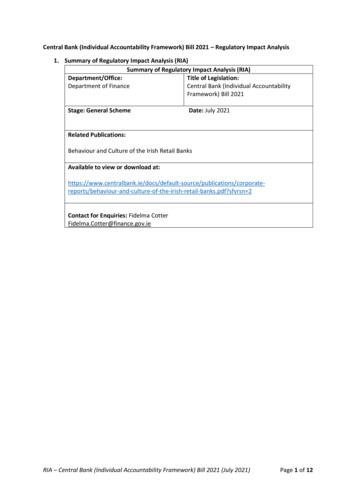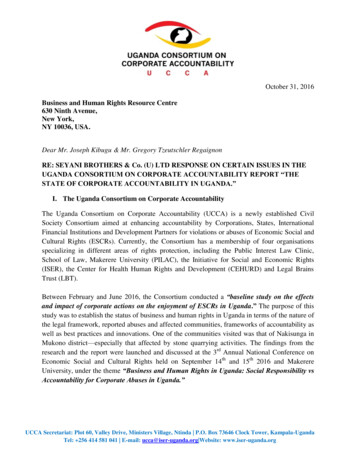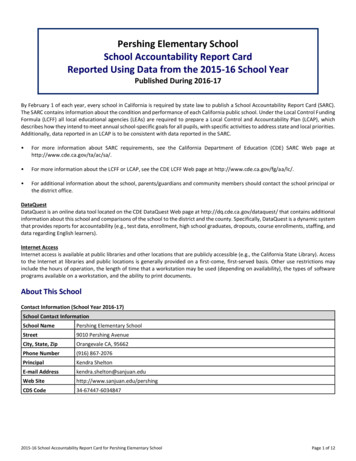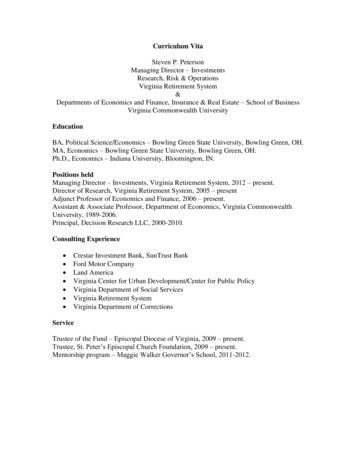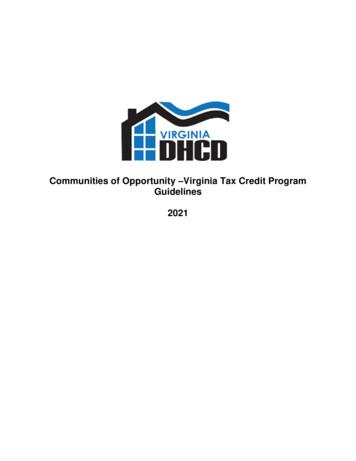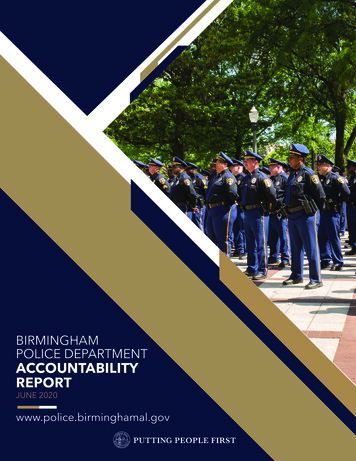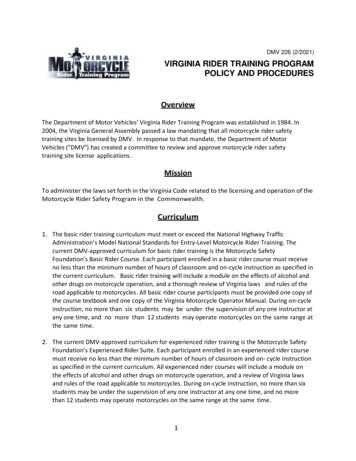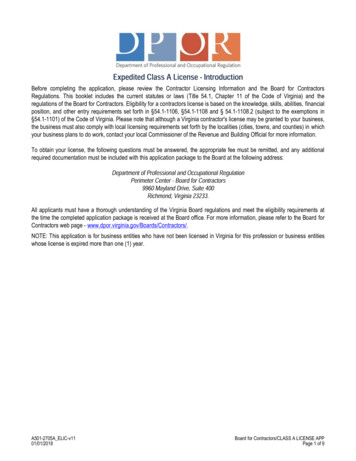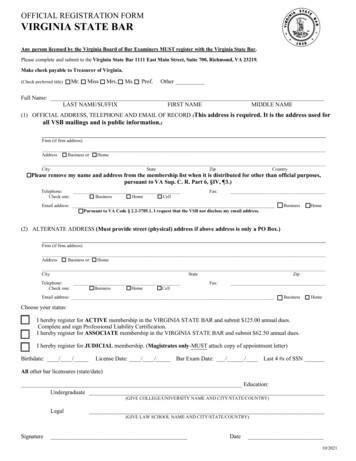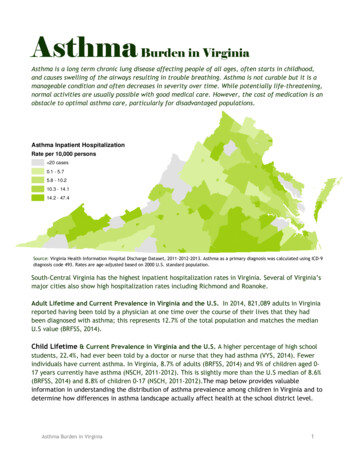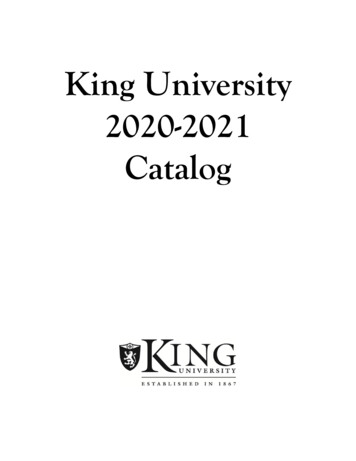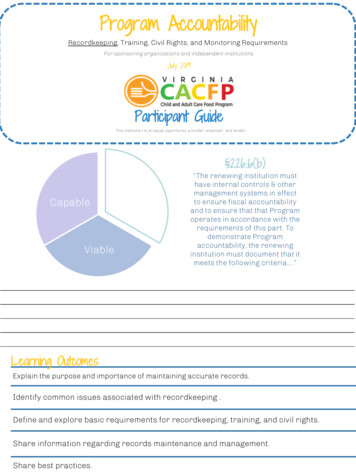
Transcription
Program AccountabilityRecordkeeping, Training, Civil Rights, and Monitoring RequirementsFor sponsoring organizations and independent institutionsJuly 2019Participant GuideThis institution is an equal opportunity provider, employer, and lender.§226.6(b)CapableViable“The renewing institution musthave internal controls & othermanagement systems in effectto ensure fiscal accountabilityand to ensure that that Programoperates in accordance with therequirements of this part. Todemonstrate Programaccountability, the renewinginstitution must document that itmeets the following criteria .”Learning OutcomesExplain the purpose and importance of maintaining accurate records.Identify common issues associated with recordkeeping .Define and explore basic requirements for recordkeeping, training, and civil rights.Share information regarding records maintenance and management.Share best practices.
What is a record?7 CFR 226.15(e)7 CFR 226.16(e)RecordkeepingRecord (noun): A thing constituting a piece of evidence about the past, especially anaccount of an act or occurrence kept in writing or some other permanent form.Independent institutions and sponsoring organizations must establishand consistently following procedures for collecting, maintaining, andretrieving records for their center or sponsored facilities. Recordscan be both in electronic and paper form.For sponsoring organizations of multiple facilities, thesestandard operating procedures (SOP) must be inand included in.This includes written policies and procedures for both thesponsoring organizations and their facilities.Why is recordkeeping important? Records are VITAL in order to receive thecorrect reimbursements from the CACFP. Records provide PROOF that meals wereserved to enrolled participants and thatthe funds received were actually used insupport of the CACFP. They support thevalidity of claims and document Programrequirements were met. Records ensure Program SUSTAINABILITYby providing organizations with historicalProgram information that can be used forfuture Program planning and budgeting.Why do you think some organizations and facilities s t r u g g l ewith recordkeeping?Notes
Cost documentation is not appropriately maintained;Inaccurate and disorganized meal service records;Insufficient edit check processes;Required records are not maintained.; andInadequate staff training.Notes:Impacts of Poor Recordkeeping
Sponsoring Organizations (and any facilities they sponsor) areresponsible for maintaining and tracking TWO types of records.Records thatdemonstrate thesuccessful operationsof the CACFPRecords thatdemonstrate thefinancialcompliance ofthe CACFPWhat are some examples of records that you andyour facilities are required to maintain? Independent Institutions: Sponsors of facilities: Sponsored facilitiesActivity: Name that Program Record1. Working independently, review the blank Program Records chart on page 5 tofamiliarize yourself with this activity.2. Based on your current knowledge, name as many Program records as youcan in the time allotted.3. Write the type of record on a stick note and the corresponding requirementson another stick note.4. Then, determine the applicable entity who maintains the record.5. Complete your sticky note and place it on the chart hanging on the wall.Provided for this activity: Program Records worksheetProgram Records ChartSticky notes
Name That Program RecordType of ProgramRecordRequirements Meal Counts Time of service (end of dayfor DCH)By meal typeDatedMaintained separatelyfrom attendanceWho MaintainsSponsorCenterDCHProviderExemptFacilities
Name That Program RecordType of ProgramRecordRequirementsMeal Counts Time of service (end of day forDCH)* By meal type By participant (except for ES,OSHC) Dated Separate from attendanceDailyTime of serviceBy meal typeNot claimed forreimbursement Costs of meals can be part ofreported food costs Meal Counts – Adults Performing Labor to ProgramAttendanceMenus Daily Number of participants inattendance Separate from meal countsDailyDated (Month, Day, Year)Details Food Items ServedIndicate Serving SizesNote SubstitutionsContains NondiscriminationStatement Prominent Location Separate if Serving Infants Updated as necessary Required for participants witha disability if the foodsubstitution does not meet theSpecial Dietarymeal pattern requirementsPrescription Form Details information about theparticipant’s disability and listsalternate foods Signed by a State licensedmedical professionalInfant ParentChoice Form “Infant Formula Choice Form” Required for all enrolledinfants Updated as necessary toreflect developmental changes(readiness) of the infant Signed by parent/guardianWho emptFacilitiesX* Meal counts forOSHC and EMS arenot required to be atPOS; must keeprecord of thenumber of mealsprepared, mealsserved, and numberof participants inattendance for eachmeal OSHCXXADCCCEMSHSOSHCXCCEMSHSXADCOSHC
Name That Program RecordType of ProgramRecordRequirements Updated as necessary Commercially processedcombination dishes: CN labelChild Nutrition (CN)or manufacturer’s productLabel, Recipes, &analysis sheet requiredMeal Production Homemade dishes: recipeRecordsrequired Quantity of each component Total servings , serving sizesWho MaintainsSponsorNeeds itiesXEnrollment Annual: CC, HS, FDCH At enrollment, updated asnecessary: ADC Participant’s full name Age DOB Normal hours/days of care Signed by parent/guardian(child) Signed byguardian/participant (adult) Newest State agency formXADCCCHSXEMSOSHCIncome EligibilityForm Annual Household income Number of members inhousehold Signed by parent/guardian(child) Signed byguardian/participant (adult) Indication of categoricaleligibility Last four digits of tion Tier 1 classificationdocumentation Tier II classificationdocumentation Best practice Updated monthlyMaster Enrollment Currently enrolledListparticipants ClassificationXXADCCCEMSHSOSHCX
Name That Program RecordType of ProgramRecordTrainingRequirements Date Annual (unless newstaff/facility) Location Topics Name(s), signature(s),position(s) of attendees Support documentation Monitoring ApplicationDocumentation Pre-Approval VisitsLocation, DateAnnounced/UnannouncedFive Day ReconciliationMeal Pattern ComplianceLicensing or ApprovalcomplianceAttendance at trainingverificationRecordkeeping verificationMeal service Problems notedCorrective action prescribedand effectivenessSignature of Monitor andCenter Rep.See application training(s)Agreement(s)Management PlanCivil Rights Data CollectionLicenses/ApprovalField Trip NotificationWho is list is not all inclusive. Please see 7 CFR 226., USDA and State agency Policy Memos, USDA Handbooks, 7 CFR 200,796-2 Rev. 4, and other State agency or USDA materials for all requirements.Notes:
Name That Financial RecordType of ProgramRecordBankStatements/Cancelled ChecksRequirements To document non-profitfood servicePayroll verificationReimbursementdistribution verificationWho emptFacilities
Name That Financial RecordType of ProgramRecordBankStatements/Cancelled uirements Merchant’s nameDateItems purchasedPrice of each itemTotal amount of billMethod of paymentDonation receipts Rates of payHours of workPolicy and schedule forregular compensation,overtime, etc.Requirements of US Dept.of Labor FLSA Payroll Time DistributionLogTo document non-profitfood servicePayroll verificationReimbursementdistribution verification Employee’sname//IdentificationnumberRate of payHours workedBenefits earnedReduction or increase tobase payGross payNet payDate of paymentMethod of paymentVerification that employeehas been paidDate//Dates workedEmployee name// IDnumberRate of payTotal payTotal hours workedHours (by day) in foodservice/administrativedutiesSignature by employee andsupervisorWho ProviderExemptFacilities
Name That Financial RecordType of ProgramRecordRequirements Facility FundsIntegrity(ReimbursementDocumentation) Procurement Name of facilityFacility’s CHAAMPS IDnumberMeal counts and cost dataidentified with the date theinformation was receivedReimbursement claimedon behalf of the facilityAmount and date of thereimbursement paymentIncome to the Programfrom all sourcesWho emptFacilitiesProcedures that reflectState, local, and tribal lawsand regulationsWritten standards ofconductRationale for procurementmethodSelection contractContractorselection//rejectionProcedures fortransactionsFor sealed bids: firm fixedprice contract issued tothe lowest bidder*This list is not all inclusive. Please see 7 CFR 226., USDA and State agency Policy Memos,USDA Handbooks, 7 CFR 200, 796-2 Rev. 4, and other State agency or USDA materials forall requirements.Notes:
Maintaining and Managing Records . is it REALLY Necessary?YESRememberList the reasons why having good records is important whendemonstrating how your CACFP reimbursements are utilized: if you do not have accurate records to show that meals wereserved and funds were spent on allowable costs, thenreimbursements will be denied.Records ManagementTwo important aspects of effectively managing records arerecords and them when requested.Independent institutions and sponsoring organizations areresponsible and accountable to the State agency for recordsmaintenance.Records RetentionRecords should be maintained for three previous years plus the current year unless there isan audit finding or outstanding Program debt. Then the records must be maintained until theaudit finding is resolved or the debt paid. Terminated sponsors and facilities are required tomaintain records according to the requirements. Termination relieve them oftheir recordkeeping requirements.Also, maintaining electronic/automated records does not necessarily mean that you’re incompliance. For example, if your software crashes and you don’t not have back-up records,you may not be in compliance with the Program.
Records RetrievalRecords must be readily available for retrieval and access upon request.If records are maintained onsite, online, or in the cloud, then your staff should be able toaccess them within one hours. If they are maintained in paper form and stored offsite, youshould be able to retrieve them within forty-eight hours.Important These are general federal guidelines. Confirm with the Stateagency if you have any questions.Notes:Let’s consider a few best practices for recordkeeping. These are not requirements, justrecommendations for you to consider and share with your facilities.Keep records organized by and .Check your files periodically to ensure the records are still accurate and complete.Ensure your staff has access to paper and electronic records.Having electronic records necessarily mean you’re in compliance.For independent, sponsoring organizations and their facilities, maintain theplus months onsite. As a reminderare required to maintain the plus the previousmonths onsite.Store offsite records in a safe place and keep them confidential.Produce records, when requested, within a reasonable timeframe: Current year Prior years ( ) within hours.List other best practices identified by the class:
RecapPurpose of recordkeepingRecord VarietyRecord AvailabilityImpact of Non-Compliance
can in the time allotted. 3. Write the type of record on a stick note and the corresponding requirements . attendance for each meal served. . Please see 7 CFR 226., USDA and State agency Policy Memos, USDA Handbooks, 7 CFR 200, 796-2 Rev. 4, and other State agency or USDA materials for all requirements. Notes: Name That Financial Record
